
10 Steps to Set Up a Magento 2 E-Wallet
Stores with e-wallets see a 25% increase in repeat purchases. Magento 2 e-wallet helps enhance customer loyalty by providing a secure and convenient payment option.
In this tutorial, we will explore the top providers and configuration steps of Magento 2 e-wallet.
Key Takeaways
-
E-wallets improve customer convenience and loyalty.
-
Follow the steps to set up an e-wallet in Magento 2.
-
Enhance store performance and security with e-wallet solutions.
-
Boost customer retention with rewards and flexible wallet features.
-
Customize the e-wallet interface to align with your brand.
What is Magento 2 E-Wallet?
Magento 2 E-Wallet is a feature that allows customers to store funds in a digital wallet within a Magento store.
The prepaid system simplifies payments. It is by enabling customers to use their wallet balance for purchases. It offers smooth:
-
Checkout
-
Transaction history
-
Refund management
Store owners benefit from reduced reliance on external payment gateways and improved customer retention. The e-wallet supports loyalty programs and promotions to encourage usage. These include cashback incentives.
Magento 2 e-wallet creates a faster, more engaging shopping experience. It is by enhancing payment convenience and offering promotional opportunities. It helps boost merchants' sales and customer loyalty.
Key Features of Magento 2 E-Wallet
1. Prepaid Wallet System
-
The Magento wallet functions as a prepaid system where customers can add funds in advance.
-
These funds are stored securely and can be used for purchases whenever needed. The approach eliminates the hassle of repeatedly processing payments.
-
It helps make shopping more efficient for returning customers. It also promotes responsible spending by allowing users to allocate a specific budget for shopping.
2. Transaction History
-
Customers gain full transparency with a detailed transaction log that includes:
1. Deposits
2. Payments
3. Refunds
-
They can view all wallet activities within their account. It helps ensure they have a clear understanding of how their funds are being used.
-
It builds trust and allows users to manage their wallet balance effectively.
3. Refunds Credited to Wallet
-
Store owners can issue refunds for canceled orders or returns directly to the customer’s wallet.
-
The process is faster than traditional refund methods. It encourages customers to spend the refunded amount on future purchases within the same store.
-
It is a benefit for both customers and merchants.
4. Cashback and Reward Programs
-
Merchants can implement reward systems like cashback or bonus credits to encourage wallet usage.
-
Customers might receive a 5% cashback when they load a certain amount into their wallet or use it for purchases.
-
Such incentives help:
1. Boost wallet adoption
2. Increase customer engagement
3. Promote repeat purchases
5. Advanced Admin Management
-
Store administrators have full control over wallet operations. They can:
1. Adjust wallet balances for specific customers.
2. Set minimum and maximum wallet limits.
3. Define rules for wallet usage, such as restricting certain products or categories.
4. Monitor wallet activity to prevent misuse or fraudulent transactions.
-
The powerful management system ensures smooth wallet functionality. It also aligns the store with store policies.
6. Flexible Wallet Funding Options
-
Customers can top up their wallets using a variety of payment methods, including:
1. Credit/debit cards
2. Bank transfers
3. Integrated payment gateways
-
The flexibility helps users to keep their wallet balance updated. It also encourages frequent usage.
7. Customer Loyalty and Retention
-
The e-wallet builds loyalty by creating a dedicated ecosystem for customer payments.
-
Exclusive offers and promotions tied to wallet use encourage customers to shop more frequently.
-
A satisfied and engaged customer base leads to long-term retention and higher lifetime value.
8. Customizable Wallet Interface
-
Merchants can tailor the wallet’s appearance and functionality to align with their brand.
-
Store owners have the flexibility to design an e-wallet experience. It should resonate with their target audience. They can include custom labels and unique wallet workflows.
How to Set Up an E-Wallet in Magento 2?
1. Log in to the Magento admin panel.
2. Go to Stores > E-Wallet > Configuration.
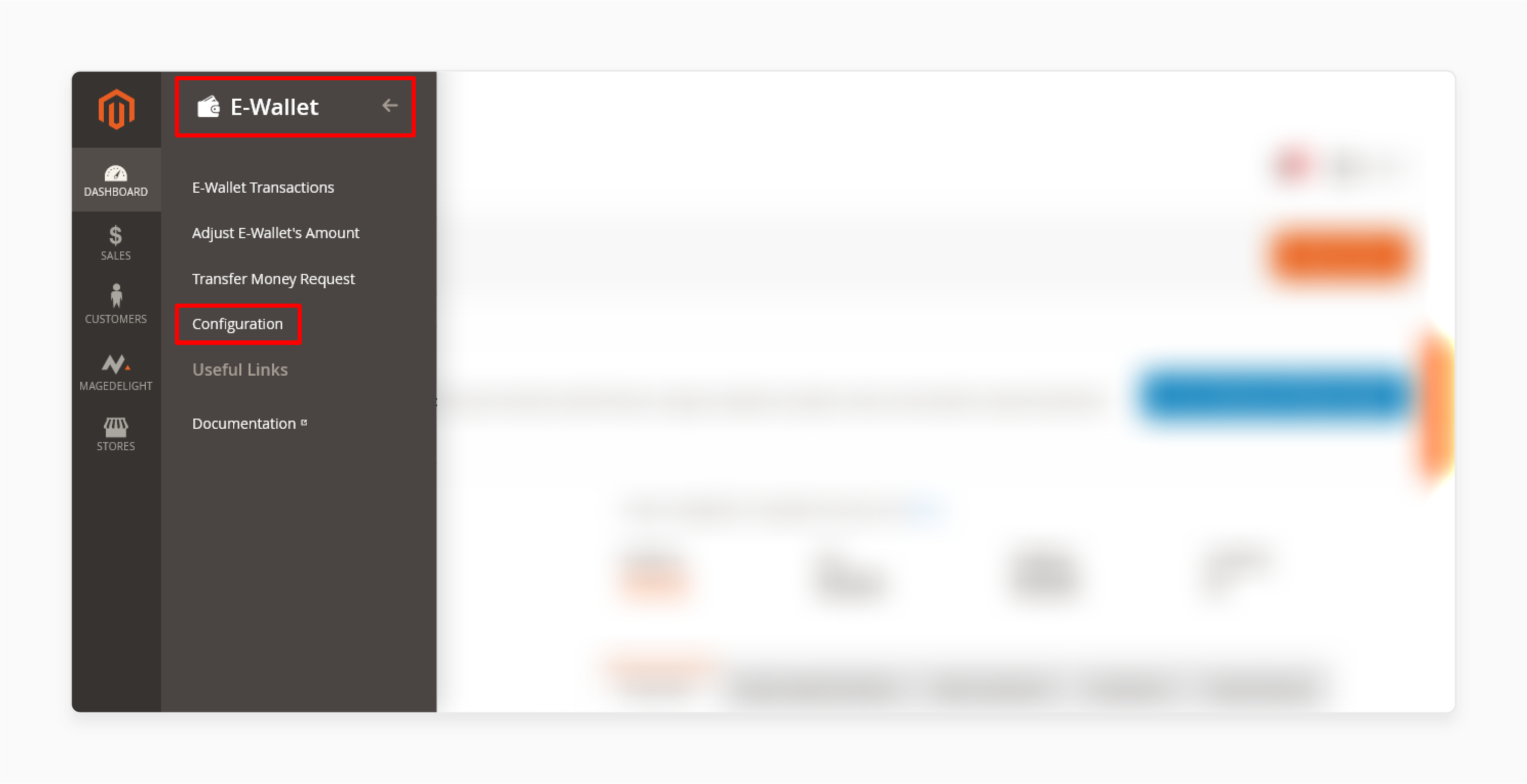
3. Expand the General section and configure:
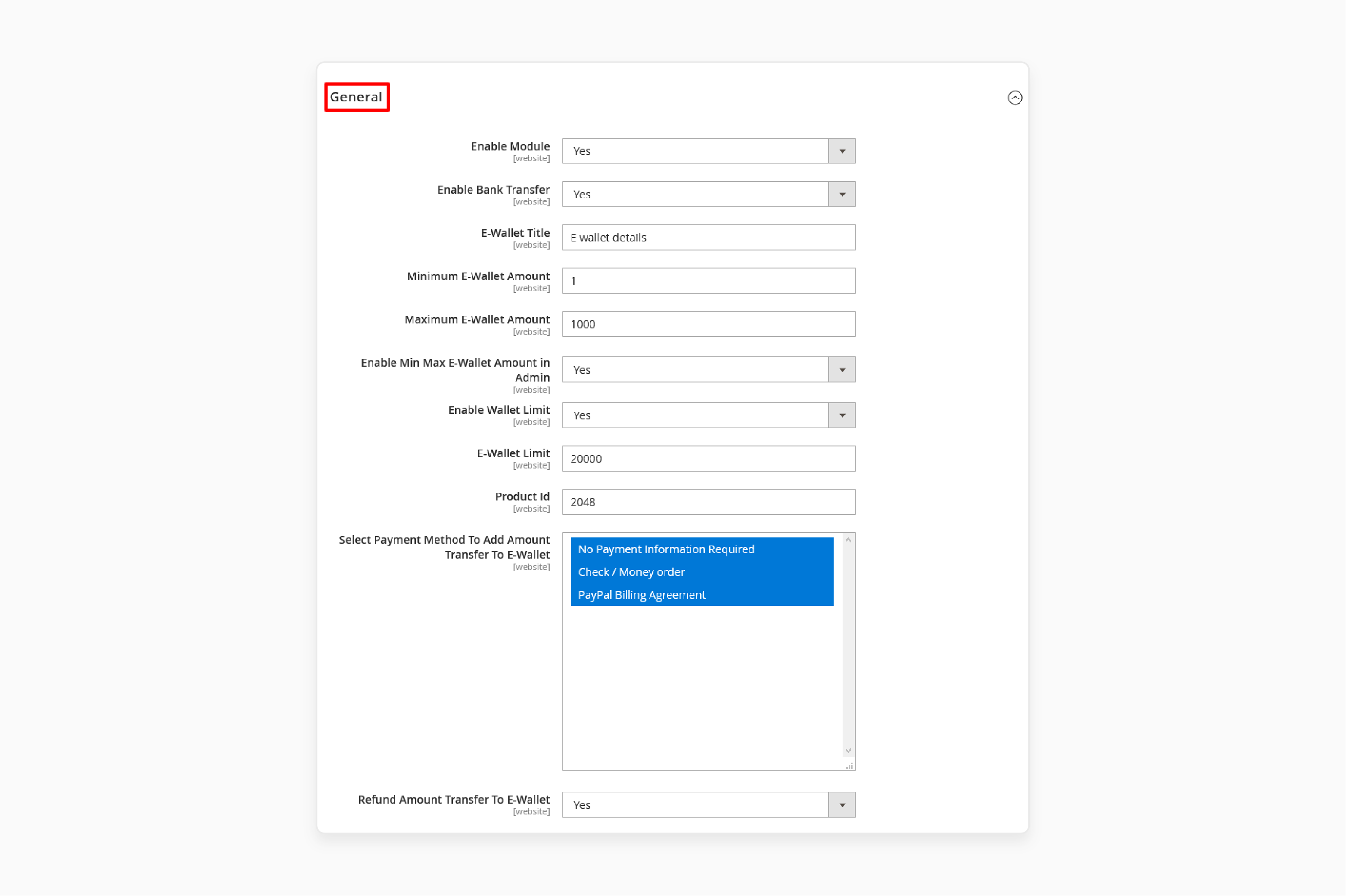
-
Select YES in the Enable Module field.
-
Select YES in the Enable Bank Transfer field.
-
Write a text title in the E-Wallet Title field.
-
Write a numeric value in the Minimum E-Wallet Amount field.
-
Write a numeric value in the Maximum E-Wallet Amount field.
-
Select YES in the Admin field to Enable Min Max E-Wallet Amount.
-
Select YES in the Enable Wallet Limit field.
-
Write a numeric value in the E-Wallet Limit field.
-
Write a numeric value in the Product ID field.
-
Select the payment methods you want to use in the Select Payment Method To Add Amount Transfer To E-Wallet field.
-
Select YES in the Refund Amount Transfer to E-Wallet field.
4. Expand the E-Wallet Transactions Email section and adjust these settings:
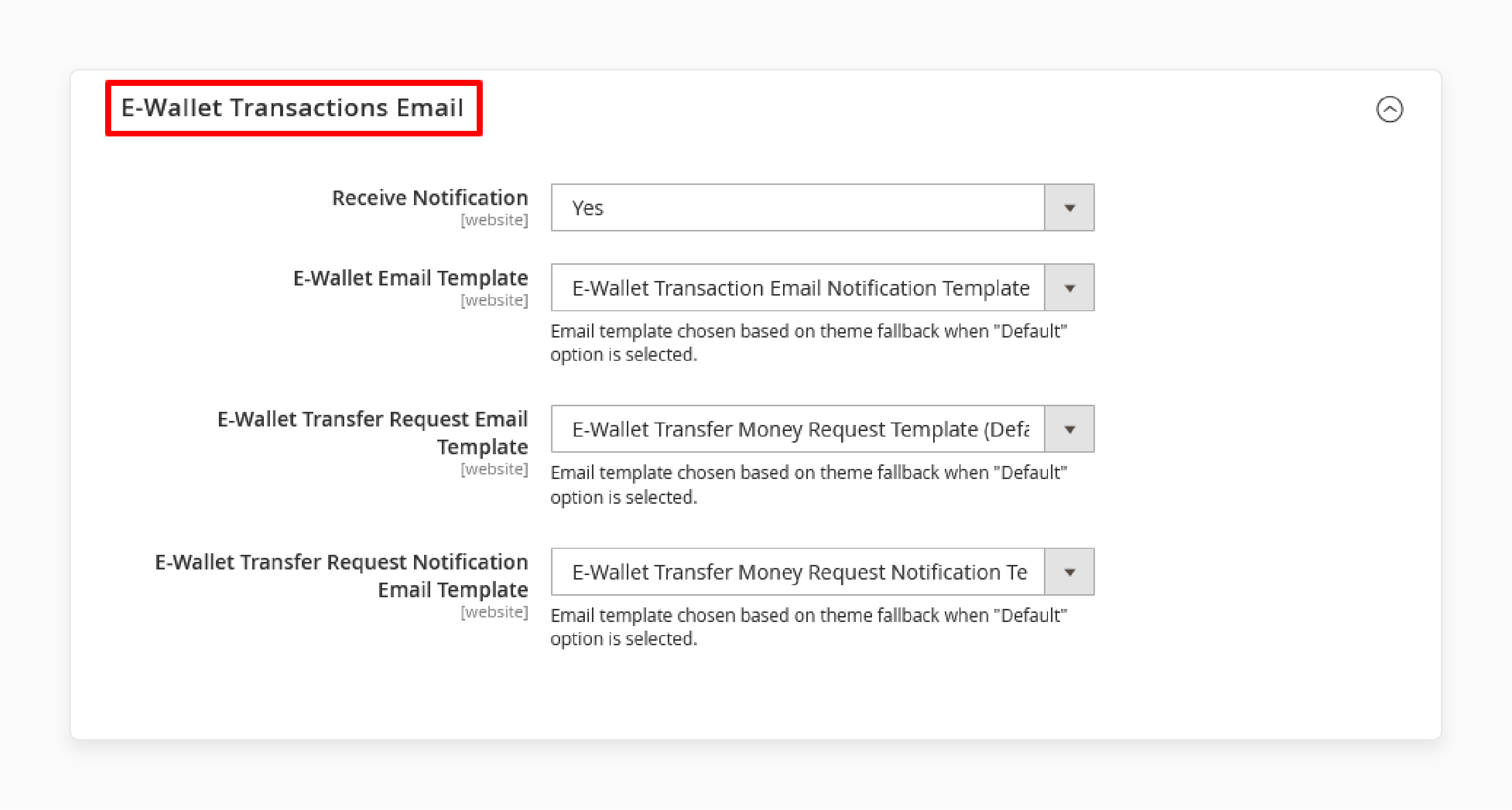
-
Select YES in the Receive Notification field.
-
Select “E-Wallet Transaction Email Notification Template” in the E-Wallet Email Template field.
-
Select “E-Wallet Transfer Money Request Template (Default)” in the E-Wallet Transfer Request Email Template field.
-
Select “E-Wallet Transfer Money Request Notification Template (Default)” in the E-Wallet Transfer Request Notification Email Template field.
Prerequisites of Magento 2 E-Wallet
1. Magento 2 Installation
-
You should ensure a functional Magento 2 setup. Your store should be running on a supported Magento 2 version, such as Magento Open Source or Magento Commerce.
-
Ensure the core Magento installation is properly configured and up-to-date. It helps avoid compatibility issues with the e-wallet extension.
2. E-Wallet Extension
-
Install a trusted Magento 2 wallet extension. Choose a reliable provider with features that suit your business needs. These include:
1. Transaction logs
2. Refund options
3. Cashback programs
4. Multi-currency compatibility
-
Verify the extension's compatibility with your current Magento version before installation.
3. Payment Gateway Integration
-
Payment gateways help customers to load funds into their wallets.
-
Ensure your store is integrated with widely used gateways like:
1. PayPal
2. Stripe
3. Local providers in your target region
-
Confirm the e-wallet extension supports these gateways for smooth wallet funding.
4. SSL Certificate
-
A valid SSL certificate helps secure data transfers between your:
1. Store
2. Customers
3. Payment processors
-
It encrypts sensitive information such as payment details and wallet transactions. It also helps build customer trust and protects against cyber threats.
5. Admin Access and Permissions
-
Ensure you have administrative rights to install and configure the e-wallet extension.
-
Admin privileges help:
1. Manage wallet settings
2. Adjust customer balances
3. Set transaction limits
4. Monitor wallet activities
6. Database Backup
-
Back up your Magento database before installing the e-wallet extension. The precaution minimizes the risk of data loss or corruption during the installation process.
-
A full backup ensures you can restore your store to its previous state if issues arise.
7. Test Environment
-
Set up a staging environment to test the e-wallet extension. It is done before deploying it on your live store.
-
It allows you to evaluate its functionality and identify bugs. It also helps resolve conflicts with other extensions or themes. It doesn’t disrupt your live store operations.
8. Clear Wallet Policies and Terms
-
Define and communicate clear policies for wallet usage. This includes:
1. Expiry dates for wallet funds
2. Refund and cashback rules
3. Limits on wallet usage per transaction or customer
4. Steps to resolve wallet-related disputes
-
Display these policies prominently on your website. It helps ensure customers understand the terms and conditions.
9. Training for Admins and Staff
-
Train your admin team or store managers to use the e-wallet extension effectively.
-
They should know how to:
1. Manage wallet settings
2. Process refunds
3. Resolve customer queries related to wallet usage
10. Legal and Compliance Considerations
-
Verify that the e-wallet complies with legal requirements and financial regulations in your operating regions.
-
It may include:
1. Anti-money laundering (AML) rules
2. Data protection laws
3. Customer verification processes
Top 2 Providers of Magento 2 E Wallet Extension
1. Magento 2 eWallet Extension - Magedelight
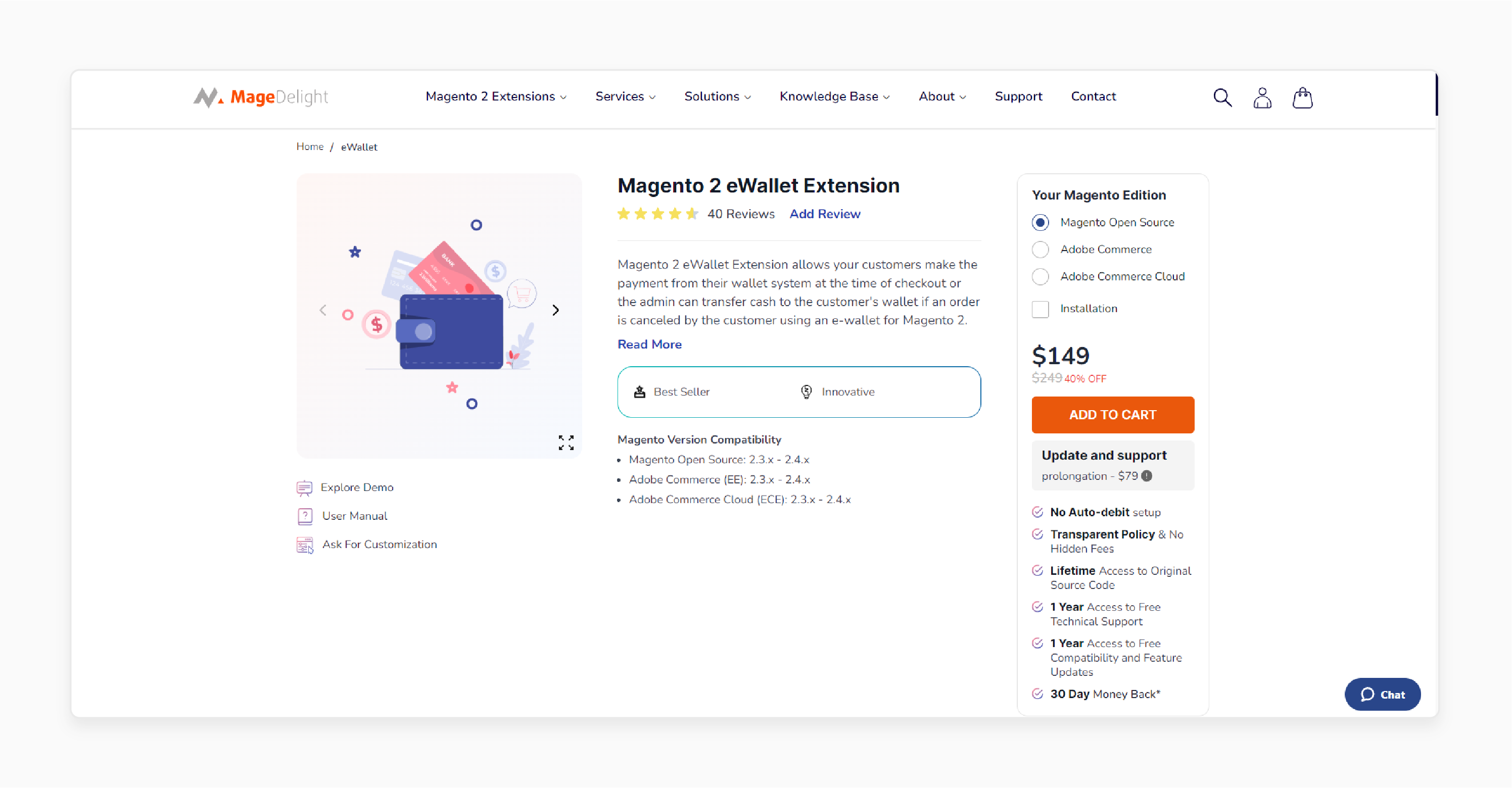
Magedelight’s eWallet extension allows your customers to make the payment from their wallet system. It is done at the time of checkout. The admin can transfer cash to the customer's wallet if the customer cancels an order. The Magento 2 extension is compatible with Magento 2.3.x - 2.4.x.
Key Features:
-
REST APIs available
-
Let the user select the wallet as a payment option on checkout
-
Pay for the same order with eWallet as well as other payment
-
Refund cash to customers’ digital wallet
-
Deduct and credit the amount from the customer’s eWallet
-
View the detailed eWallet transaction history of each customer
Price:
-
Magento Open Source Edition: $199 (12 months)
-
Magento Adobe Commerce Edition: $399 (12 months)
-
Magento Adobe Commerce Cloud Edition: $499 (12 months)
2. E-wallet for Magento 2 - MageHQ
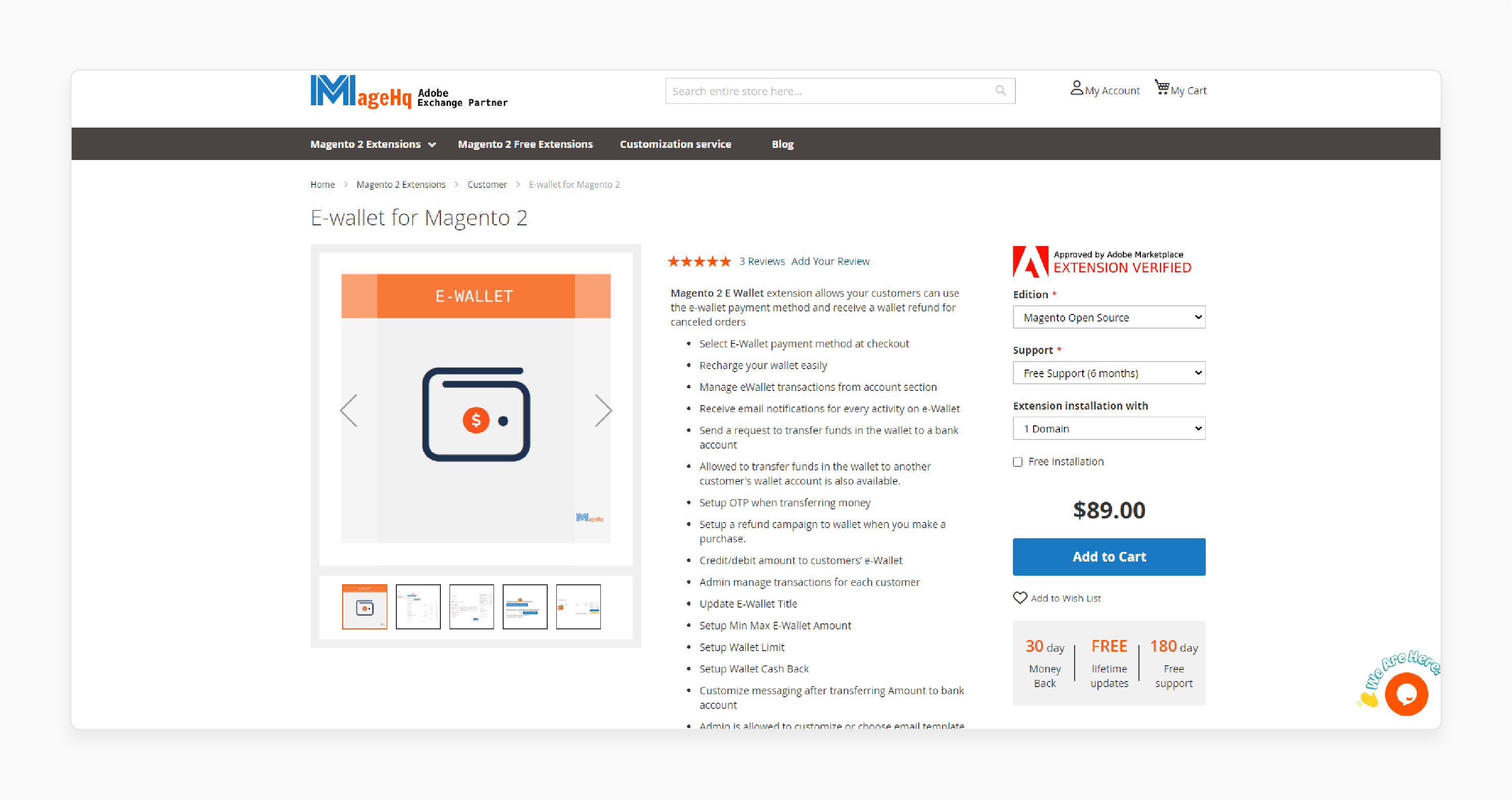
MageHQ’s Magento 2 e-wallet extension allows your customers to use the wallet payment method. They also receive a wallet refund for canceled orders. The extension for Magento 2 is compatible with Magento 2.3.x and 2.4.x.
Key Features:
-
Select the online payment method at checkout
-
Recharge your wallet easily
-
Manage eWallet transactions from the account section
-
Receive email notifications for every activity on e-Wallet
-
Send a request to transfer funds in the wallet to a bank account
-
Allowed to transfer funds in the wallet to another customer's wallet account is also available.
-
Setup OTP when transferring wallet money
-
Set up a refund campaign in your wallet when you make a purchase.
-
Transfer the wallet amount to the customers’ e-wallet
-
Admin manages transactions for each customer
-
Update e-wallet title
-
Setup min max wallet amount
-
Setup wallet money limit
-
Setup wallet cash back
-
Customize messaging after transferring the amount to the bank account
-
Admin is allowed to customize or choose the email template
Price:
-
Magento Open Source Edition: $174 (12 months)
-
Magento Adobe Commerce Edition: $254 (12 months)
Common Challenges and Solutions of Magento 2 E-Wallet
1. Integration Issues
Conflicts arise when integrating the e-wallet with third-party extensions or payment gateways.
Solution:
-
Always test the wallet system for Magento 2 in a staging environment. It should be done before deploying them on your live site.
-
Use wallet extensions explicitly designed for Magento 2. Avoid outdated or unsupported plugins.
-
Work with a certified Magento developer to resolve complex integration issues if necessary.
2. Security Concerns
Storing and handling sensitive customer data can lead to vulnerabilities.
Solution:
-
Secure all wallet-related transactions using SSL to protect data in transit.
-
Follow Payment Card Industry (PCI) standards to ensure secure payment processing.
-
Apply Magento security patches as soon as they are released to address vulnerabilities.
-
Use Magento-compatible fraud prevention tools to monitor suspicious activities.
3. Limited Wallet Features
Basic e-wallet functionality may not meet customer expectations.
Solution:
-
The extension should offer advanced features like cashback rewards and promotional top-ups.
-
Invest in feature-rich e-wallet extensions that provide a comprehensive range of options for both customers and store admins.
4. Performance Issues
E-wallet functionality can slow down site performance.
Solution:
-
Work with developers to clean up and optimize the codebase of the Magento 2 wallet system for better performance.
-
Utilize Magento’s built-in caching system to reduce server load.
-
Use tools like New Relic or GTmetrix to identify bottlenecks and address them promptly.
5. Customer Adoption Challenges
Customers may hesitate to use the wallet system payment method due to unfamiliarity or lack of trust.
Solution:
-
Offer discounts or cashback for customers who use the e-wallet for their transactions.
-
Provide clear instructions, tooltips, or videos explaining how to use the e-wallet effectively.
-
Add security badges and testimonials to reassure customers about the safety and reliability of the e-wallet.
6. Refund and Dispute Handling
Managing wallet refunds and customer disputes can be complex.
Solution:
-
Use predefined rules to automate wallet refunds, ensuring faster resolutions.
-
Clearly outline your refund and dispute resolution policies on your website. Ensure that they are easy for customers to understand.
-
Equip your support team to handle wallet-related queries and disputes efficiently.
FAQs
1. How does the Magento 2 wallet system work?
The Magento 2 wallet system module allows customers to add money to their wallets. They can use it to make online payments during checkout. Customers can easily select the payment method using the wallet system. They can have the amount deducted from the customer’s wallet.
2. What happens if the wallet does not have enough funds?
If the wallet does not have enough balance, customers can use another payment method. It can be used at the time of checkout to pay the remaining amount. It ensures smooth transactions on a Magento 2 store.
3. Can admins configure the Magento wallet system?
Admin can configure the Magento wallet system by setting limits and managing transactions. They can also approve a wallet amount transfer request. The wallet extension allows customers to enjoy flexible and secure payments.
4. What are the benefits of Magento 2 wallet features?
The features of the Magento 2 wallet include cashback rewards and the ability to credit the amount into the customer’s wallet. It also offers refunds to the customer’s wallet system. These enhance the shopping experience in a Magento store.
Summary
Magento 2 e wallet allows customers to store and use prepaid funds for smoother payments and better engagement. The tutorial explores the key features of the extension, including:
-
Customers preload funds for secure, hassle-free shopping.
-
Logs track deposits, payments, and refunds for clear fund management.
-
Refunds go to wallets, encouraging reuse; cashback boosts engagement.
-
Wallet design and security features align with store branding and safety needs.
Boost your store's performance with Magento 2 e-wallet integration. Pair it with managed Magento hosting for a faster, more secure shopping experience.





